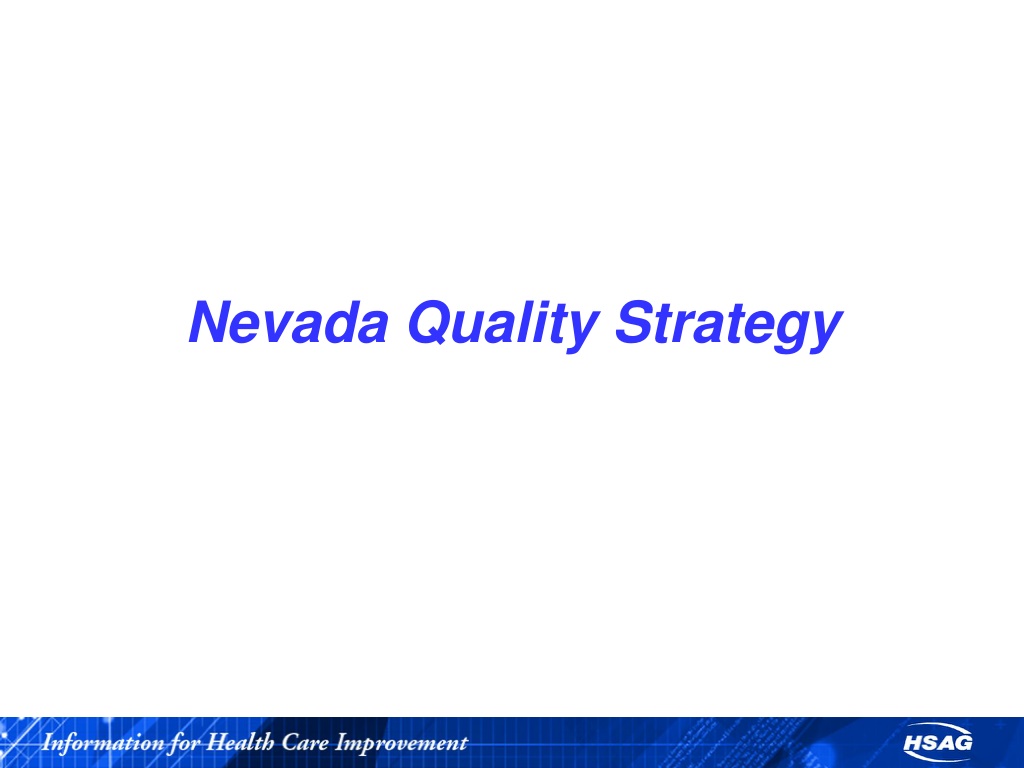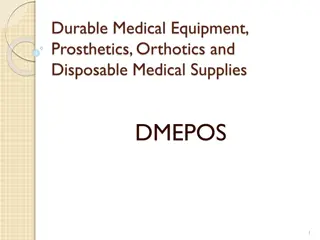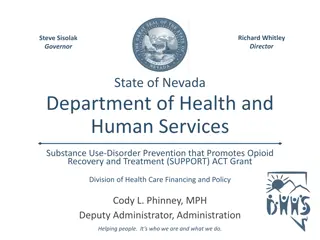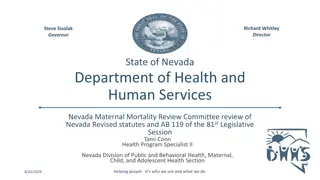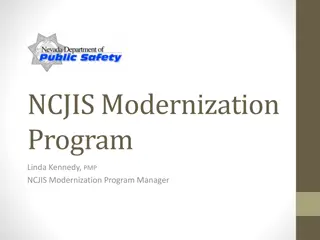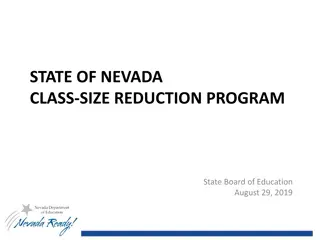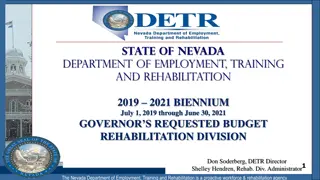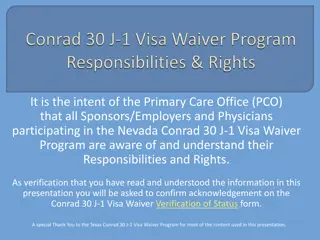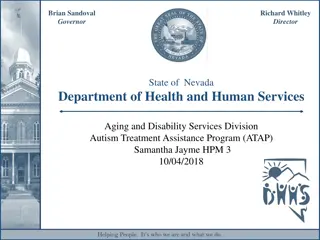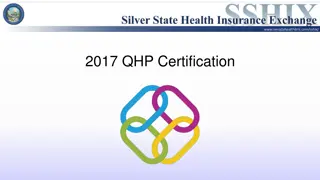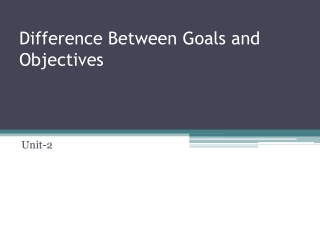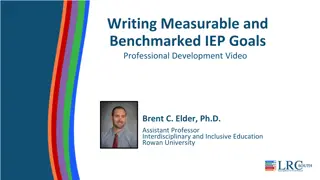Nevada Quality Strategy 2014-2015 DHCFP Goals and Objectives
The Nevada Quality Strategy for 2014-2015 DHCFP aims to improve the health and wellness of the state's Medicaid and Check Up population by enhancing preventive services and treatment practices. Goals include increasing access to primary care, promoting well-child visits, and reducing health care disparities through cultural competency and data stratification. By aligning with national quality frameworks, the strategy emphasizes continual assessment and improvement of quality, access, and timeliness of services delivered to recipients.
Download Presentation

Please find below an Image/Link to download the presentation.
The content on the website is provided AS IS for your information and personal use only. It may not be sold, licensed, or shared on other websites without obtaining consent from the author. Download presentation by click this link. If you encounter any issues during the download, it is possible that the publisher has removed the file from their server.
E N D
Presentation Transcript
State Quality Strategy Purpose Align with CMS National Quality Framework and CMS Triple Aim Maintain a common vision for Nevada Medicaid Serves as the vehicle by which the State communicate its quality goals and objectives to stakeholders Provides framework to continually assess and improve quality, access, and timeliness of services delivered to Medicaid recipients Maintains compliance with federal regulations
2014-2015 DHCFP Quality Strategy Goals and Objectives Goal 1: Improve the health and wellness of Nevada s Medicaid and Check Up population by increasing the use of preventive services, thereby modifying health care use patterns for the population. Objective 1.1: Increase children s and adolescents access to PCPs by 10 percent.1 Objective 1.2: Increase well-child visits (0 15 months) by 10 percent. Objective 1.3: Increase well-child visits (3 6 years) by 10 percent. Objective 1.4: Increase the prevalence of blood lead testing for children 1 2 years of age by 10 percent. Objective 1.5: Decrease avoidable emergency room visits by 10 percent. 1-The goal for all measures to increase performance by 10 percent refers to the hybrid QISMC methodology for reducing the gap between the performance measure rate and 100 percent by 10 percent.
2014-2015 DHCFP Quality Strategy Goals and Objectives Goal 2: Increase use of evidence-based preventive and treatment practices for members with chronic conditions. Objective 2.1: Increase rate of HbA1c testing for members with diabetes by 10 percent. Objective 2.2: Increase rate of monitoring nephropathy for members with diabetes by 10 percent. Objective 2.3: Increase LDL-C screening for members with diabetes by 10 percent.
2014-2015 DHCFP Quality Strategy Goals and Objectives Goal 3: Reduce and/or eliminate health care disparities for Medicaid and Nevada Check Up recipients. Objective 3.1: Ensure that health plans develop, submit for review, and annually revise cultural competency plans, which detail the health plans goals, objectives, and processes for reducing and/or eliminating racial or ethnic disparities that negatively impact the quality and timeliness of, and access to, health care. Objective 3.2: Stratify data for performance measures and avoidable emergency room utilization by race and ethnicity to determine where disparities exist. Continually identify, organize, and target interventions to reduce disparities and improve access to appropriate services for the Medicaid and Check Up population. Objective 3.3: Ensure that the MCOs submit an annual evaluation of their cultural competency program to the DHCFP. The MCOs must receive a 100 percent Met compliance score for all of the criteria listed in the MCO contract for cultural competency program development, maintenance, and evaluation.
2014-2015 DHCFP Quality Strategy Goals and Objectives Goal 4: Improve the health and wellness of new mothers and infants and increase new-mother education about family planning and newborn health and wellness. Objective 4.1: Increase the rate of postpartum visits by 10 percent.
Monitoring the Quality Strategy The following activities are used to monitor achievement of the goals and objectives in the Quality Strategy Compliance Reviews: DHCFP s EQRO, Health Services Advisory Group, conducts a comprehensive review of each MCO s compliance with state and federal operational standards. Performance Measure Validation: DHCFP s EQRO validates each of the 21 performance measures MCOs are required to report and use to monitor quality and timeliness of care and access to care. Performance Improvement Project (PIP) Validation: DHCFP s EQRO validates 2 PIPs conducted by each MCO to ensure that the study is valid, reliable, and has the potential to improve care.
Monitoring the Quality Strategy Network Access Analysis: DHCFP s EQRO conducted an analysis of the provider networks for the FFS system and for each MCO. HSAG also conducted a secret shopper study to determine how long it takes to establish an appointment with a given provider type. Health Care Guidance Program (HCGP): DHCFP s EQRO has conducted a readiness review, compliance review, and validation of performance measures to monitor the HCGP s performance relative to the HCGP s Quality Strategy, which serves as Attachment C to the Nevada Quality Strategy. Consumer Assessment of Healthcare Providers and Systems (CAHPS) surveys: DHCFP s EQRO validates the sample frames used to sample the population for the CAHPS survey and reports the MCOs results in the Annual EQR Technical Report.
State Quality Strategy and EQR Compliance with Standards Medicaid CHIP Quality Timeliness State s Quality Strategy Performance Measures PIPs Access
Evaluation of the Quality Strategy Annually, DHCFP and its EQRO: Assess the completeness of the quality strategy Evaluate the effectiveness of the quality strategy Determine the extent to which the State and MCOs comply with quality standards by assessing the mandatory EQR activities: Validating performance improvement projects 438.358(b)(1) with requirements in 438.240(b)(1) Validating performance measures and results 438.358(b)(2) with requirements in 438.240(b)(2) Monitoring MCO compliance with State s contract requirements and Medicaid managed care standards 438.358(b)(3) with requirements in 438.240(b)(1)(2) Report on the MCOs achievement of goals and objectives in the EQR Technical Report
Quality Strategy Revision DHCFP updates Quality Strategy biennially to incorporate revised goals and objectives DHCFP solicits stakeholder input on the goals and objectives from: Public, via public workshops and email DHCFP staff MCOs Other DHHS divisions Revision underway for 2016-2017 Quality Strategy DHCFP posts the Quality Strategy on its web site
Stakeholder Input Requested Are there goals and objectives from 2014-2015 Quality Strategy that should be retained? Are there modifications to goals and objectives from 2014- 2015 Quality Strategy that should be made and included? What additional goals and objectives should be considered for addition in 2016-2017 Quality Strategy? Are the goals and objectives, existing or newly proposed, appropriate goals for both fee-for-service and managed care benefit plans? Are there any other state or local public health initiatives that should be included in the State s 2016-2017 Quality Strategy?
Submitting Input Please submit input to Tracy Palmer, Social Services Chief II at: tracy.palmer@dhcfp.nv.gov
